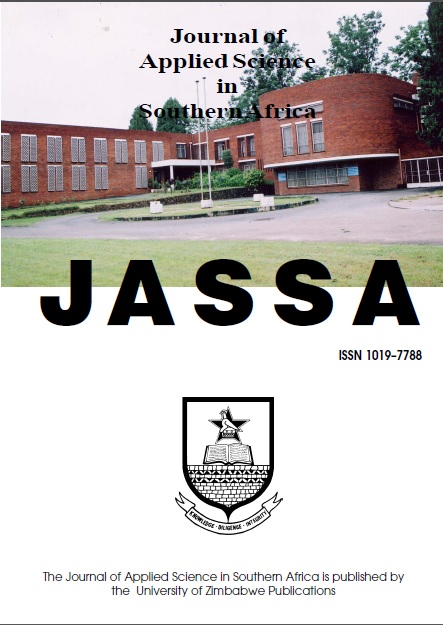
JOURNAL OF APPLIED SCIENCE IN SOUTHERN AFRICA
University of Zimbabwe Publications
DOI: 10.5897/UJ-JASSA
Email: uzpub@admin.uz.ac.zw
Allelopathic potential of sorghum, wheat and maize residue extracts on germination and early establishment of Amaranthus hybridus L. and Rottboellia cochinchinensis L.
DOI: 10.5897/UJ-JASSA.17.005.2 | Article Number: 653537865 | Vol.22 (2) - December 2016
Authors: Mhungu S. , Tibugari H. , Mandizvidza L. , Rugare J. , Mandumbu R. and Karavina, C.
Keywords: Allelopathy, mulch, Rottboellia cochinchinensis, Amaranthus hybridus, weed management
Allelopathy is an unexploited phenomenon in Zimbabwe which has the potential for use in weed management. There is need for a paradigm shift towards ecologically sound and affordable weed management methods. This study investigated the allelopathic effects of maize, sorghum and wheat extracts on germination and early establishment of Amaranthus hybridus and Rottboellia cochinchinensis. The bioassay had 50 and 100% concentration of sorghum, maize and wheat residue extracts. The results indicated that 50% sorghum resulted in the lowest germination (P<0.05) for A. hybridus and for R cochinchinensis (P<0.05). Wheat at 100% resulted the highest germination for both shamva grass and pigweed. Leaf lengths were not affected by residue extracts. A hybridus dry matter was not affected by type and rate of extracts. R cochinchinensis however showed a significantly lower dry matter at 100% sorghum residue extracts and at 50% wheat residue extracts. Wheat and sorghum resulted in significant weed suppression compared to maize and pure water. The sorghum and wheat mulches can therefore be used in suppressing the germination and early establishment of the two weeds.
AKOBUNDU, O. (1987). Weed science in the tropics: principles and practices (Chapter 3). John Wiley and Sons. Chichester.
ALTIERI M.A. AND DOLL J.D. (1978). The potential of allelopathy as a tool for weed management in crop fields. Pest Articles News Summary (PANS) 24: 495-498.
CALLAWA, R.M AND ASHEHOUG, E. T. (2000). Invasive plants versus their new and old neighbours: A mechanism of exotic invasion. Science 290: 521-523.
BUDD, C. (1975). A second survey of arable lands of Rhodesia. Rhodesia Agric Journal 73 (6): 152-160.
CHEEMA, Z. A. AND KHALIQ, A. (2000). The use of sorghum allelopathic properties to control weeds in irrigated wheat in the semi-arid region of Punjab. Agriculture, Ecosystems and Environment 79: 105-112.
CHEEMA, Z.A. (1988). Weed control in wheat through sorghum allelochemicals. PhD Thesis, Agronomy Department, University of agriculture, Faisalabad, Pakistan.
CHIKOYE, D., MANYONG, V.M. AND EKELEME, F. (2000). Characteristics of spear grass (Imperata cylindrica) dominated fields in West Africa: Crops, soil properties, farmer perceptions and management strategies. Crop Protection 19: 481-487.
CHIVINGE, O.A. (1983). A weed survey of arable lands in the commercial sector of Zimbabwe. Zimbabwe Agriculture Journal 80: 39-41.
CHIVINGE, O.A. (1984). The role of herbicide technology on small scale farms in Zimbabwe. Zimbabwe Agric Journal 18: 97-102.
CHIVINGE, O.A (1988). A survey of weeds in arable lands in small scale farming sector of Zimbabwe. Zambezia 15: 167-178.
CHIVINGE, O.A. (1990). Weed science technological needs for communal areas of Zimbabwe. Zambezia XVII (ii): 133-143.
GUENZI, W. AND MCCALLA, T. (1966). Phenolics acids in oats, wheat, sorghum and corn residues and their toxicity. Agronomy Journal 58: 303-304.
HUSSAIN, F. AND GADOON, M.A. (1981) Allelopathic effects of sorghum vulgare. Ecologia 51: 284–288.
INTERJIT (1996). Plant phenolics in allelopathy. Botanical Reviews 62: 182-202 LEGERE, A. AND SCHREIBER M.M. (1989). Competition and canopy architecture as affected by soyabeans (Glycine max) row width and density of red root pigweed (Amaranthus retroflexus). Weed Science 37: 84-92.
NETZLEY D.H. AND BUTLER L.G. (1986). Root of sorghum exudes hydrophobic droplets containing biologically active components. Crop Science 26: 775-778.
NIEMEYER, H.M. (1988). Hydroxamic acids (4-hydroxy-1, 4 benzoxaazin-3-ones), defence chemicals in graminae. Phytochemicals 27: 267-292.
PUTNAM A. R. (1985). Weed allelopathy. In Weed physiology, reproduction and ecophysiology. Eds Duke S.O. CRC Press. Florida 132-150.
SCHENK H.J., CALLAWAY R.M. AND MARSHALL B.E. (1999). Spatial root segregation: are plants territorial. Advances in Ecological Research 28: 146-180.
RIBEIRO J.P.N (2011). Global effect index: a new approach to analyzing allelopathy survey data. Weed Science 59: 113-118.
ZIMDHAHL R.L (1999). Fundamentals of weed science (second edition) (Chapter 3). Academic Press, New York.
